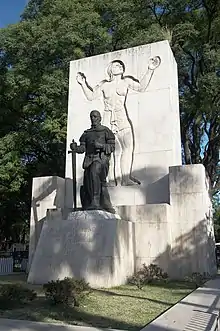1537
Year 1537 (MDXXXVII) was a common year starting on Monday (link will display the full calendar) of the Julian calendar.
| Millennium: | 2nd millennium |
|---|---|
| Centuries: | |
| Decades: | |
| Years: |
| 1537 by topic |
|---|
| Arts and science |
|
| Leaders |
|
| Birth and death categories |
| Births – Deaths |
| Establishments and disestablishments categories |
| Establishments – Disestablishments |
| Works category |
|
| Gregorian calendar | 1537 MDXXXVII |
| Ab urbe condita | 2290 |
| Armenian calendar | 986 ԹՎ ՋՁԶ |
| Assyrian calendar | 6287 |
| Balinese saka calendar | 1458–1459 |
| Bengali calendar | 944 |
| Berber calendar | 2487 |
| English Regnal year | 28 Hen. 8 – 29 Hen. 8 |
| Buddhist calendar | 2081 |
| Burmese calendar | 899 |
| Byzantine calendar | 7045–7046 |
| Chinese calendar | 丙申年 (Fire Monkey) 4233 or 4173 — to — 丁酉年 (Fire Rooster) 4234 or 4174 |
| Coptic calendar | 1253–1254 |
| Discordian calendar | 2703 |
| Ethiopian calendar | 1529–1530 |
| Hebrew calendar | 5297–5298 |
| Hindu calendars | |
| - Vikram Samvat | 1593–1594 |
| - Shaka Samvat | 1458–1459 |
| - Kali Yuga | 4637–4638 |
| Holocene calendar | 11537 |
| Igbo calendar | 537–538 |
| Iranian calendar | 915–916 |
| Islamic calendar | 943–944 |
| Japanese calendar | Tenbun 6 (天文6年) |
| Javanese calendar | 1455–1456 |
| Julian calendar | 1537 MDXXXVII |
| Korean calendar | 3870 |
| Minguo calendar | 375 before ROC 民前375年 |
| Nanakshahi calendar | 69 |
| Thai solar calendar | 2079–2080 |
| Tibetan calendar | 阳火猴年 (male Fire-Monkey) 1663 or 1282 or 510 — to — 阴火鸡年 (female Fire-Rooster) 1664 or 1283 or 511 |
Events
January–June
- January
- Bigod's Rebellion, an uprising by Roman Catholics against Henry VIII of England, is crushed.
- Battle of Ollantaytambo: Emperor Manco Inca Yupanqui is victorious against the Spanish and their Indian allies led by Hernando Pizarro.
- March – Diego de Almagro successfully charges Manco Inca's siege of Cuzco, thereby saving his antagonists, the Pizarro brothers.
- March 12 – Recife is founded by the Portuguese, in Brazil.
- April – Spanish conquest of the Muisca: Bacatá, the main settlement of the Muisca Confederation, is conquered by Gonzalo Jiménez de Quesada, effectively ending the Confederation in the Colombian Eastern Andes.[1]
- April 1 – The Archbishop of Norway Olav Engelbrektsson flees from Trondheim to Lier, Belgium.
- June 2 – Pope Paul III publishes the encyclical Sublimis Deus, which declares the natives of the New World to be rational beings with souls, who must not be enslaved or robbed.
- June 23 – Siege of Hamar ends with the arrest of Bishop Mogens Lauritssøn, and the Catholic rebellion is definitively ended in Norway.
July–December
- July – Rodrigo Orgóñez occupies and sacks the Inca center of Vitcos but Manco Inca Yupanqui escapes and establishes the independent Neo-Inca State elsewhere in Vilcabamba, Peru.
- August 15 – Asunción is founded by Juan de Salazar de Espinosa.
- August 25 – The Honourable Artillery Company, the oldest surviving regiment in the British Army, and the second most senior, is formed.
- August-September – The Ottoman Empire fails to capture Corfu, but this year does conquer the islands of Paros and Ios.
- October 15 – Following the baptism of her son, the future Edward VI of England, Jane Seymour begins suffering from puerperal fever.[2]
Date unknown
- The Spaniards bring the potato to Europe.
- Kiritimati (Acea or "Christmas Island") is probably sighted by the Spanish mutineers from Hernando de Grijalva's expedition.
- Bangalore is first mentioned.
- Dissolution of the monasteries in Norway: Religious buildings dissolved by Christian III include: Bakke Abbey, Munkeby Abbey, Tautra Abbey, Nidarholm Abbey, Gimsøy Abbey and Utstein Abbey.
- Publication of complete Bible translations into English, both based on Tyndale's:
Ongoing
- Dissolution of the monasteries in England: Religious buildings dissolved by Henry VIII of England include: Bisham Priory, Bridlington Priory, Castle Acre Priory, Chertsey Abbey, Furness Abbey, London Charterhouse and Valle Crucis Abbey.
Births

Willem IV van den Bergh
- January 1 – Jan Krzysztof Tarnowski, Polish noble (d. 1567)
- January 16 – Albrecht VII, Count of Schwarzburg-Rudolstadt (d. 1605)
- January 21 – Antonio Maria Salviati, Italian Catholic cardinal (d. 1602)
- February 26 – Christopher II, Margrave of Baden-Rodemachern (d. 1575)
- March 17 – Toyotomi Hideyoshi, Japanese warlord (d. 1598)
- March 4 – Longqing Emperor, Emperor of China (d. 1572)
- May 18 – Guido Luca Ferrero, Italian Catholic cardinal (d. 1585)
- May 20 – Hieronymus Fabricius, Italian anatomist (d. 1619)
- May 27 – Louis IV, Landgrave of Hesse-Marburg, son of Landgrave Philip I (d. 1604)
- May 28 or May 31 – Shah Ismail II of Persia (d. 1577)
- June 3 – João Manuel, Prince of Portugal, Portuguese prince (d. 1554)
- July 20 – Arnaud d'Ossat, French diplomat and writer (d. 1604)
- July 29 – Pedro Téllez-Girón, 1st Duke of Osuna, Spanish duke (d. 1590)
- July 30 – Christopher, Duke of Mecklenburg and administrator of Ratzeburg (d. 1592)
- August 9 – Francesco Barozzi, Italian mathematician (d. 1604)
- August 15 – Shimazu Toshihisa, Japanese samurai (d. 1592)
- October – Lady Jane Grey, claimant to the throne of England (d. 1554)[3][4]
- October 12 – King Edward VI of England (d. 1553)[2]
- November 21 – Fadrique Álvarez de Toledo, 4th Duke of Alba, Spanish military leader (d. 1583)
- December 5 – Ashikaga Yoshiaki, Japanese shōgun (d. 1597)
- December 20 – King John III of Sweden (d. 1592)[5]
- December 24 – Willem IV van den Bergh, Stadtholder of Guelders and Zutphen (d. 1586)
- December 26 – Albert, Count of Nassau-Weilburg (d. 1593)
- date unknown
Deaths
_-_Santa_Maria_della_Salute_-_Venice_2016_(2).jpg.webp)
Saint Gerolamo Emiliani

Pedro de Mendoza
- January 6
- January 12 – Lorenzo di Credi, Florentine painter and sculptor (b. 1459)
- February 2 – Johann Carion, German astrologer and chronicler (b. 1499)
- February 3 – Thomas FitzGerald, 10th Earl of Kildare, Anglo-Irish noble, rebel (executed) (b. 1513)
- February 8
- January 11 – John, Hereditary Prince of Saxony, German prince (b. 1498)
- March 25 – Charles, Duke of Vendôme, French noble (b. 1489)
- March 28 – Francesco of Saluzzo, Marquess of Saluzzo (b. 1498)
- May 10 – Andrzej Krzycki, Polish archbishop (b. 1482)
- May 24 – Sophie of Brandenburg-Ansbach-Kulmbach, German princess (b. 1485)
- June 2 – Francis Bigod, English noble, rebel (executed) (b. 1507)
- June 23 – Pedro de Mendoza, Spanish conquistador (b. 1487)
- June 29 – Henry Percy, 6th Earl of Northumberland, English noble (b. 1502)
- July 7 – Madeleine of Valois, queen of James V of Scotland (b. 1520)[6]
- July 12 – Robert Aske, English lawyer, rebel (executed) (b. 1500)
- September 4 – Johann Dietenberger, German theologian (b. c. 1475)
- September 7 – Nikolaus von Schönberg, German Catholic cardinal (b. 1472)
- September 20 – Pavle Bakić, last Serb Despot and medieval Serb monarch
- October 24 – Jane Seymour, 3rd queen consort of Henry VIII of England (complications of childbirth) (b. c. 1508)[2]
- October 29 – Elizabeth Lucar, English calligrapher (b. 1510)
- December 11 – Andrey of Staritsa, son of Ivan III of Russia the Great (b. 1490)
- date unknown – John Kite, Archbishop of Armagh and Bishop of Carlisle
- probable – Thomas Murner, German satirist (b. 1475)
References
- Kathleen Romoli (1944). Colombia: Gateway to South America. Doubleday, Doran, Incorporated. p. 105.
- Carole Levin; Anna Riehl Bertolet; Jo Eldridge Carney (November 3, 2016). A Biographical Encyclopedia of Early Modern Englishwomen: Exemplary Lives and Memorable Acts, 1500-1650. Taylor & Francis. p. 280. ISBN 978-1-315-44071-2.
- David Mathew (1972). Lady Jane Grey: the Setting of the Reign. Eyre Methuen Limited. p. 34. ISBN 978-0-413-27980-4.
- "BBC - History - Historic Figures: Lady Jane Grey (1537 - 1554)". www.bbc.co.uk. Retrieved March 22, 2019.
- Encyclopedia Americana: Jefferson to Latin. Scholastic Library Pub. 2006. p. 114. ISBN 978-0-7172-0139-6.
- Anne Commire (December 12, 2000). Women in World History. Gale. p. 292. ISBN 978-0-7876-4069-9.
This article is issued from Wikipedia. The text is licensed under Creative Commons - Attribution - Sharealike. Additional terms may apply for the media files.
